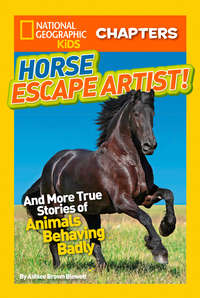
Полная версия
National Geographic Kids Chapters: Hoot, Hoot, Hooray!: And More True Stories of Amazing Animal Rescues

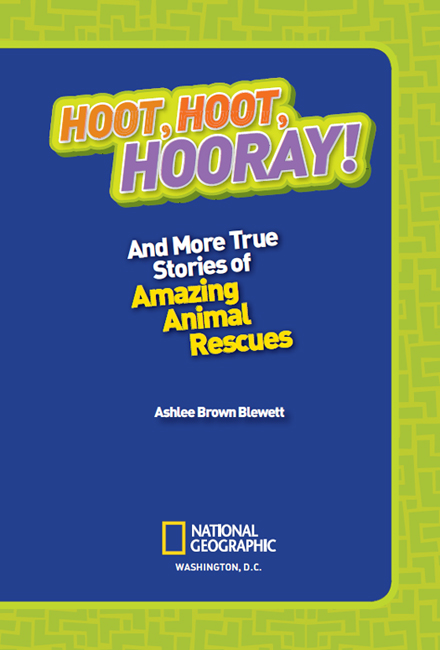
Copyright © 2015 National Geographic Society
All rights reserved. Reproduction of the whole or any part of the contents without written permission from the publisher is prohibited.
Staff for This Book
Shelby Alinsky, Project Editor
Jay Sumner, Photo Editor
Callie Broaddus, Art Director
Ruth Ann Thompson, Designer
Marfé Ferguson Delano, Editor
Paige Towler, Editorial Assistant
Sanjida Rashid, Design Production Assistant
Colm McKeveny and Michael Cassady, Rights Clearance Specialists
Grace Hill, Managing Editor
Mike O’Connor, Production Editor
Lewis R. Bassford, Production Manager
George Bounelis, Manager, Production Services
Susan Borke, Legal and Business Affairs
Published by the National Geographic Society
Gary E. Knell, President and CEO
John M. Fahey, Chairman of the Board
Melina Gerosa Bellows, Chief Education Officer
Declan Moore, Chief Media Officer
Hector Sierra, Senior Vice President and General Manager, Book Division
Senior Management Team, Kids Publishing and Media Nancy Laties Feresten, Senior Vice President; Jennifer Emmett, Vice President, Editorial Director, Kids Books; Julie Vosburgh Agnone, Vice President, Editorial Operations; Rachel Buchholz, Editor and Vice President, NG Kids magazine; Michelle Sullivan, Vice President, Kids Digital; Eva Absher-Schantz, Design Director; Jay Sumner, Photo Director; Hannah August, Marketing Director; R. Gary Colbert, Production Director
Digital Anne McCormack, Director; Laura Goertzel, Sara Zeglin, Producers; Jed Winer, Special Projects Assistant; Emma Rigney, Creative Producer; Brian Ford, Video Producer; Bianca Bowman, Assistant Producer; Natalie Jones, Senior Product Manager

The National Geographic Society is one of the world’s largest nonprofit scientific and educational organizations. Founded in 1888 to “increase and diffuse geographic knowledge,” the Society’s mission is to inspire people to care about the planet. It reaches more than 400 million people worldwide each month through its official journal, National Geographic, and other magazines; National Geographic Channel; television documentaries; music; radio; films; books; DVDs; maps; exhibitions; live events; school publishing programs; interactive media; and merchandise. National Geographic has funded more than 10,000 scientific research, conservation, and exploration projects and supports an education program promoting geographic literacy.
For more information, please visit nationalgeographic.com, call 1-800-NGS LINE (647-5463), or write to the following address:
National Geographic Society
1145 17th Street N.W.
Washington, D.C. 20036-4688 U.S.A.
Visit us online at nationalgeographic.com/books
For librarians and teachers:
ngchildrensbooks.org
National Geographic supports K–12 educators with ELA Common Core Resources. Visit natgeoed.org/commoncore for more information.
More for kids from National Geographic:
kids.nationalgeographic.com
For information about special discounts for bulk purchases, please contact National Geographic Books Special Sales: ngspecsales@ngs.org
For rights or permissions inquiries, please contact National Geographic Books Subsidiary Rights: ngbookrights@ngs.org
Trade paperback
ISBN: 978-1-4263-2054-5
Reinforced library edition
ISBN: 978-1-4263-2055-2
eBook ISBN: 978-1-4263-2200-6
v3.1
Version: 2017-07-10
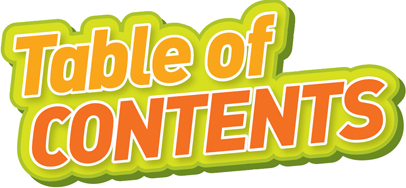
Cover
Title Page
Copyright
PAUL AND BABE: Hoot, Hoot, Hooray!
Chapter 1: Timber!
Chapter 2: Raptor Rescue
Chapter 3: Hoot, Hoot, Hooray!
ZONGOLONI: Operation Elephant Rescue!
Chapter 1: Brave Little Calf
Chapter 2: Learning to Trust
Chapter 3: Wild Again
HEAVENLY: Brave Bear!
Chapter 1: Mountaintop Rescue
Chapter 2: Time to Heal
Chapter 3: A Forever Home
DON’T MISS!
Chapter 1: Pouch Pet
More Information
Author’s Note
Dedication
Credits
Acknowledgments
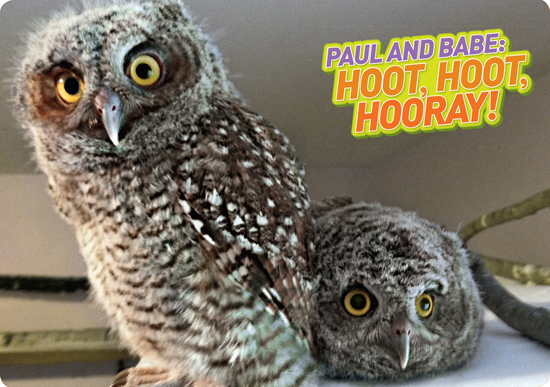
Baby owl Paul stands beside his sister, Babe. Eastern screech-owls can be red, like Paul, or gray, like Babe. (photo credit p01.1)
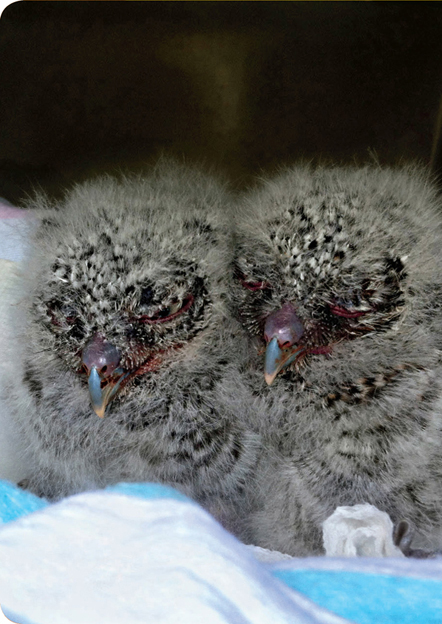
When Homer Kuhn found these little baby owls, their eyes were still closed. (photo credit p01.2)
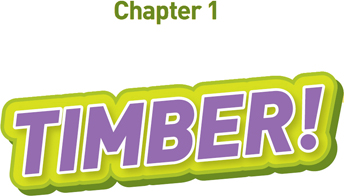
May 1, 2013 New Creek, West Virginia, U.S.A.
It was a sunny day, without a cloud in the sky. Birds chirped, squirrels barked, hawks screamed, and a family of deer ate grass near the edge of the woods. Woodcutter Homer Kuhn (sounds like COON) had just finished sawing the base of a dried-out tree.
“Timber!” Homer called.
The tree hit the ground. Thud!
Homer looped a long, heavy chain around the log. His brother, Willie, pulled the log out of the forest using a large machine that looks like a tractor, called a skidder. As the log slid past Homer, a flash of white caught his eye. He thought he saw two snowballs lying on the ground. But Homer knew that they couldn’t be snowballs. It was 80°F (26.5°C) outside.
Homer says, “I thought, what in the world is lying white like that in the middle of the woods?” He walked over to investigate. Lying in the dirt were two baby eastern screech-owls.
Homer scooped up the baby owls, or owlets, in his hand. They looked like two fluffy marshmallows. Peep, peep! the owlets called. They must have fallen out of a hole in the log, Homer thought.
Some birds build nests. Not screech-owls. Instead, they nest inside tree cavities (sounds like KAV-uh-tees). These are holes made by other animals, like woodpeckers. Usually, the mother owl looks after the babies while the father owl hunts for food to bring back to the family.
Homer searched the area for the owlets’ parents. He looked inside the holes of other trees. But he found no parent owls. Homer knew that if he left the owlets in the woods with no home and no parents, they would die. He wrapped the babies in an old T-shirt. Then he pulled his cell phone out of his pocket and called the one person he knew would help.
“Hello,” said Mrs. Tammi Kuhn.
“Hi, Mom,” Homer answered. “We have something.”
“Is it squirrels again?” Mrs. Kuhn asked.
“No, we found two baby owls this time,” Homer said.
“Oh my!” said Mrs. Kuhn. “I’ll be right there.”
Mrs. Kuhn was used to getting calls like this from her sons. Homer and Willie work for a logging company. They spend most days in the woods, cutting down trees. Then they sell the logs they collect to a nearby sawmill to be cut into boards and sold as lumber. Sometimes, in the woods, the brothers find baby animals.
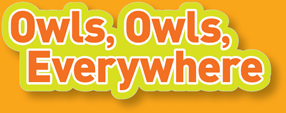
Owls live on every continent except Antarctica. They come in many shapes and sizes. The Eurasian (sounds like yur-AY-zhun) eagle-owl can grow to more than two feet (0.6 m) tall. It can weigh up to ten pounds (4.5 kg). The elf owl only grows to around six inches (15 cm) tall. It weighs less than half as much as this book. Owls’ feathers help them blend into their habitats. The snowy owl’s thick white feathers hide it from enemies in the frozen Arctic. And the gray- and rust-colored feathers of a screech-owl make it seem to disappear next to a tree.
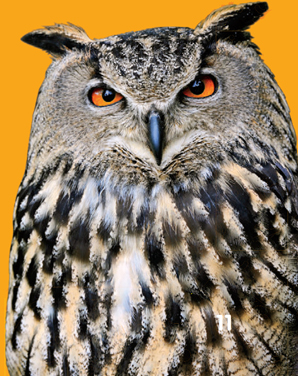
Eurasian eagle-owl (photo credit 1.1)
“If we find baby squirrels or baby raccoons, we try to rescue them,” Homer says. “We find a lot of squirrels.” When the boys spot these animals, they call their mother for help. “She raises them until they are old enough to care for themselves,” says Homer. Then Mrs. Kuhn returns the animals to the wild.
Mrs. Kuhn has raised and released many squirrels over the years. But screech-owls were different. She had never cared for screech-owls. In fact, it is illegal to raise them in West Virginia. But these babies needed help.
Mrs. Kuhn got in her car and drove to the edge of the woods. “I really didn’t know what to do with baby screech-owls, but I didn’t want them to die,” says Mrs. Kuhn. She called everyone she knew, trying to find a rescue center that could take them. Meanwhile, she drove the owlets back to her house. She put them in a box with a heating pad to keep them warm, and she did her best to feed them.
Did You Know?
There are more than 200 species (sounds like SPEE-sheez), or kinds, of owls.
In the wild, baby screech-owls stay in the nest for about one month. Then they begin to learn how to fly and hunt. After that, the parents continue to protect and feed their young owls for two or three more months, until they can hunt on their own. But the baby owls’ eyes were still closed. They were less than a week old.
Owls are carnivores (sounds like CAR-nuh-vors). They eat meat. The owlets’ parents would have fed the babies insects and small mammals, like mice. All Mrs. Kuhn had was frozen hamburger and deer meat. She thawed the meat and cut it into small chunks. Then she used tweezers to feed the meat to the “baby hooters,” as she called the owlets. She called them this because of the sound adult screech-owls make: Hoot, hoot!
Did You Know?
Different kinds of owls make different noises. Owls can purr, chirp, bark, whistle, screech, whinny, and—of course—hoot.
The hungry owlets snatched the meat from the tweezers and swallowed the chunks whole. When their bellies were full, they tucked their heads into their feathers and fell asleep.
But soon, the babies lifted their beaks into the air again. Peep, peep! they cried, begging for more food. All through the night, Mrs. Kuhn fed the baby hooters. She gave them water through an eyedropper, too. Eat, drink, sleep. Eat, drink, sleep. It went on like this for two days.
What Mrs. Kuhn didn’t know is that owls need to eat bones, hair, and feathers, too. In the wild, the owlets’ parents would have fed them the entire animal. Bones and hair help owls cough up pellets. Pellets are hard lumps the size of peanuts. They are full of the things that owls cannot digest. If owls don’t cough up pellets every day, they can get sick. The baby hooters were not coughing up new pellets. Soon they lost energy. If Mrs. Kuhn did not find the owlets help soon, they would surely die.
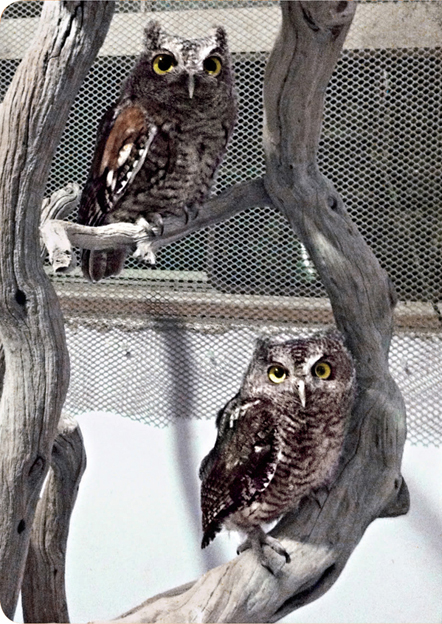
Paul, on the top branch, looks ready to test his wings. Babe is not so sure. (photo credit 1.2)
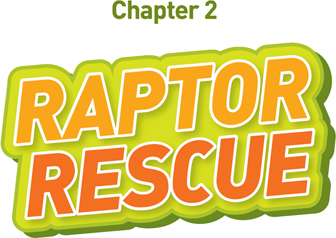
Finally, Mrs. Kuhn had an idea. She called the Maryland Department of Natural Resources, or DNR. They knew someone who could help! The next morning, Mrs. Kuhn drove the owlets to the DNR. Workers there helped get the babies to the Owl Moon Raptor Center in Boyds, Maryland, U.S.A. Raptors are birds of prey, such as eagles, hawks, and owls. They use their hooked beak and sharp talons (sounds like TAL-uns), or claws, to hunt other animals for food.
Suzanne Shoemaker runs Owl Moon out of her home. Her house sits in a patch of wooded land. Blue herons, ducks, and beavers live around a stream winding through the woods. Foxes slink across the grass.
Suzanne is a wildlife rehabilitator (sounds like ree-uh-BILL-uh-tay-ter). She has a special permit to care for hurt and orphaned raptors. She opened Owl Moon in 2002. She built two outdoor flight cages, called mews (sounds like MYOOZ), for the raptors. Once the birds are healthy, Suzanne keeps them in the mews until they are strong enough to be released back into the wild.
Suzanne turned one room of her basement into an indoor mew. She covered the windows with netting, so the birds could not fly into the glass or out an open window. And she put tree branches around the room to give the birds a natural place to perch, or stand. Suzanne wanted the mew to feel like the birds’ wild home.
Two adult screech-owls live in the indoor mew: Root’n Toot’n, a female, and Henry, a male. They play an important role at Owl Moon. They act as foster parents to baby owls that come to the center. Soon Root’n Toot’n and Henry would meet the new owlets. First, Suzanne needed to get the babies healthy.
As soon as the owlets arrived, Suzanne carried them down to the basement. She placed the owlets on a table. Then she looked them over from beak to claw. The owlets were a healthy weight. But something was wrong.
The babies had not coughed up pellets in two days. They had no energy, and they were dehydrated (sounds like dee-HYE-drate-id). This means that their bodies weren’t getting enough water. “Tammi Kuhn did the best she could caring for the owlets,” said Suzanne. “But they weren’t getting a good diet.” Now it was up to Suzanne to save them.
Suzanne sprang into action. She used a syringe (sounds like suh-RINJ) to inject fluid under the owlets’ skin. The fluid was like a clear sports drink for birds. This helped rehydrate them.
Next, Suzanne cut a dead mouse into small chunks. Suzanne calls this tasty bird treat “mouse mush.” It includes the meat, the bones, and the organs, too. The bones would help the owlets cough up pellets. Suzanne fed the babies mouse mush, using hemostats (sounds like HEE-muh-stats). Hemostats look like a pair of long, dull scissors.
Did You Know?
An eastern screech-owl can swallow a whole mouse in one gulp.
Finally, Suzanne put the babies inside an incubator (sounds like ING-kyuh-bay-tur). An incubator is a clear box. A fan pushes warm air inside the box. “At this point, the owlets needed to be kept warm, given fluids, and fed a proper diet,” Suzanne said.

Raising baby raptors is hard work. If you want to release them, it is important that the birds do not imprint on, or become attached to, humans. If a wild raptor thinks humans are friendly, it might try to approach them. This would put the bird and humans in danger. Imagine if a hawk crashed your picnic! To make sure the owlets did not imprint on her, Suzanne wore a special outfit called a ghillie (sounds like GILL-ee) suit. It looks like it is made of leaves or moss. The suit covers the entire body. It camouflages (sounds like KAM-uh-flazh-es), or hides, a human’s smell, too.
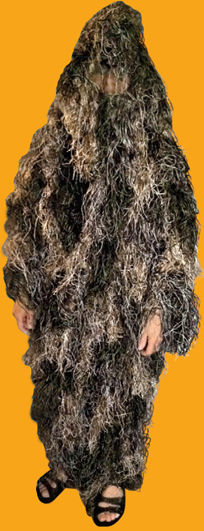
(photo credit 2.1)
If Suzanne could get the owls healthy, she might be able to release them back into the wild. Over the years, Suzanne has cared for and released more than 500 birds. Normally, she re-nests owlets. She looks for a wild screech-owl nest with one or two babies inside it. She puts the orphaned owlet in the nest with them. Then she watches to see if the parent owls will adopt the new baby. Usually they do. If she can’t find a wild nest, Suzanne puts the baby owls inside a birdhouse. Then she places the birdhouse high up in a tree near other wild owls.
Конец ознакомительного фрагмента.
Текст предоставлен ООО «ЛитРес».
Прочитайте эту книгу целиком, купив полную легальную версию на ЛитРес.
Безопасно оплатить книгу можно банковской картой Visa, MasterCard, Maestro, со счета мобильного телефона, с платежного терминала, в салоне МТС или Связной, через PayPal, WebMoney, Яндекс.Деньги, QIWI Кошелек, бонусными картами или другим удобным Вам способом.


